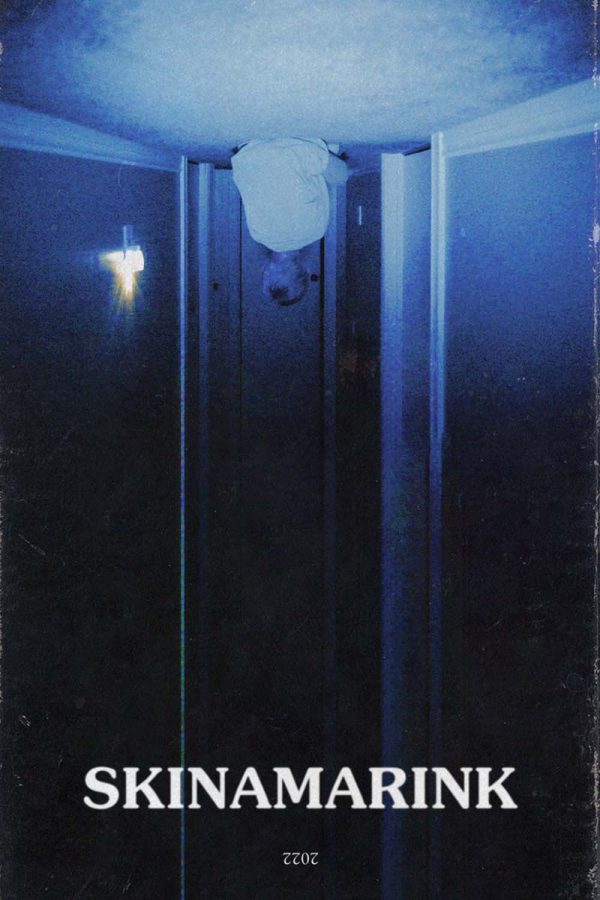There’s Someone In Your Walls: A Supposed New Twist on Found-Footage Psychological Horror
It’s not uncommon to feel as though you are hearing voices in your head. Canadian indie director Kyle Edward Ball takes this simple idea to a new level in his new movie “Skinamarink.”
The film begins as we watch a family, two young children and their father, vaguely through security cameras around their house. After one of the children, four-year-old Kevin, falls down the stairs in a sleepwalking accident, he is rushed to the hospital and brought home and put to bed.
When he wakes, their father and all doors and windows in the house have vanished. The movie follows Kevin and his younger sister as they wander throughout their home in search of their father while a mysterious entity communicates to them, almost echoing through their heads. In childish confusion, the children slowly begin to listen to the demonic voice.
What this film gets right is the constant state of dread. The cameras aren’t placed well, so we never see the faces of these children; we are only able to watch them in a cropped frame, while the audience yearns for a peek at what they are seeing. When the only supposed parental figure disappears, the children turn to the voice for guidance. There is almost a sense of nostalgia this way, knowing that these kids are too young to know any better, that they aren’t mature enough to sense this evil presence, that any state of their unknowing will soon fade into what feels like a nightmare, and that they won’t be able to stop what is coming for them.
Yet, after the film’s incredibly slow 100-minute runtime, this perfectly set-up found-footage horror movie feels like a match that failed to ignite.
My friend and I sat in silence for a moment, before she turned to me and said, “I thought I saw something… but I think I’ve just been staring at nothing for long enough that I’m seeing things.” The film had the perfect build up for a horrifying revealing climax, but the excitement never came… and when the credits rolled, we were more confused and frustrated than anything else.
So what is this movie’s fail? What made this promised “new-age horror” as advertised on social media so disappointing? Perhaps I made the mistake of not watching it alone, or maybe I went into it expecting too much of a typical horror movie. “Skinamarink” seems so obsessed with this idea of “found footage” that they use too much of it. While part of the storytelling comes from the fact that the cameras are all horribly placed, most of the film’s runtime is staring at empty walls, shut doors, and dark windows, all of which excite the viewer, almost suggesting that there is something to look for in these scenes… but after maybe an hour of these clips without the first scare yet, the viewer is bound to be bored.
In total, there are two jumpscares throughout the film, if you can even call them that. But it can also be argued that if you sit in a quiet room for 10 minutes and somebody shouts, you are bound to be startled.
I feel as though the viewer was supposed to figure something out. Yet, it was only after reading reviews written by other viewers that I was nudged in what I think is the right direction for what this movie is supposed to mean.
Michelle Boyar (ScreenRant) explains a common theory: Kevin’s fall is the only part of the movie that actually happens, and everything that follows is an endless nightmare that conjures in his mind while he’s in a coma. While this theory explains the strange numbers, the feeling of nostalgia, and the voiceless entity that communicates through his mind, I think this theory is a lame excuse for a boring movie. It’s almost as if Director Kyle Edward Ball came up with the plot as an afterthought.
Your donations directly fund the Lane Tech student journalism program—covering essential costs like website hosting and technology not supported by our school or district. Your generosity empowers our student reporters to investigate, write, and publish impactful stories that matter to our school community.
This website is more than a publishing platform—it's an archive, a research tool, and a source of truth. Every dollar helps us preserve and grow this resource so future students can learn from and build on the work being done today.
Thank you for supporting the next generation of journalists at Lane Tech College Prep!

Claudia is a sophomore at Lane and this is her first year with the Champion. She runs for the school’s Cross Country and Track team, but on her days...






